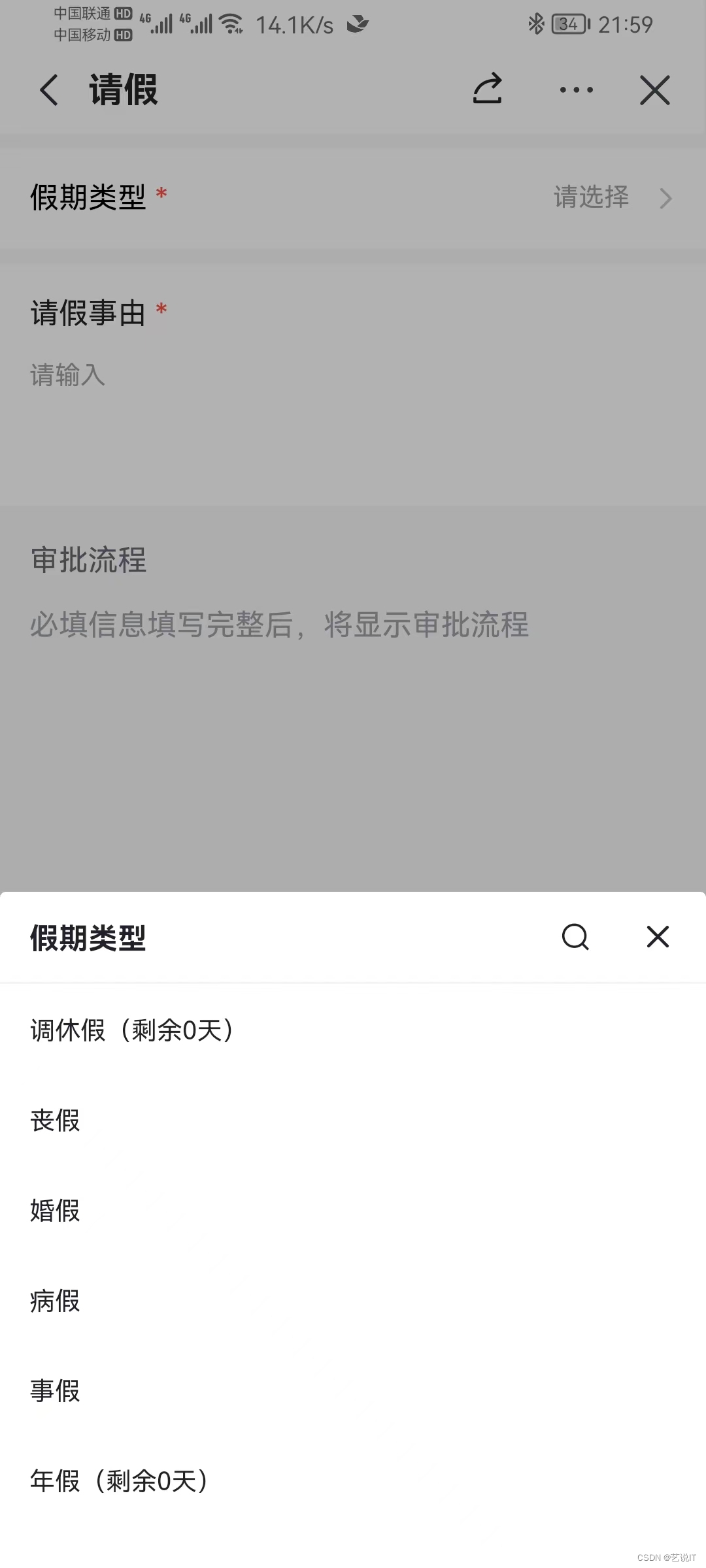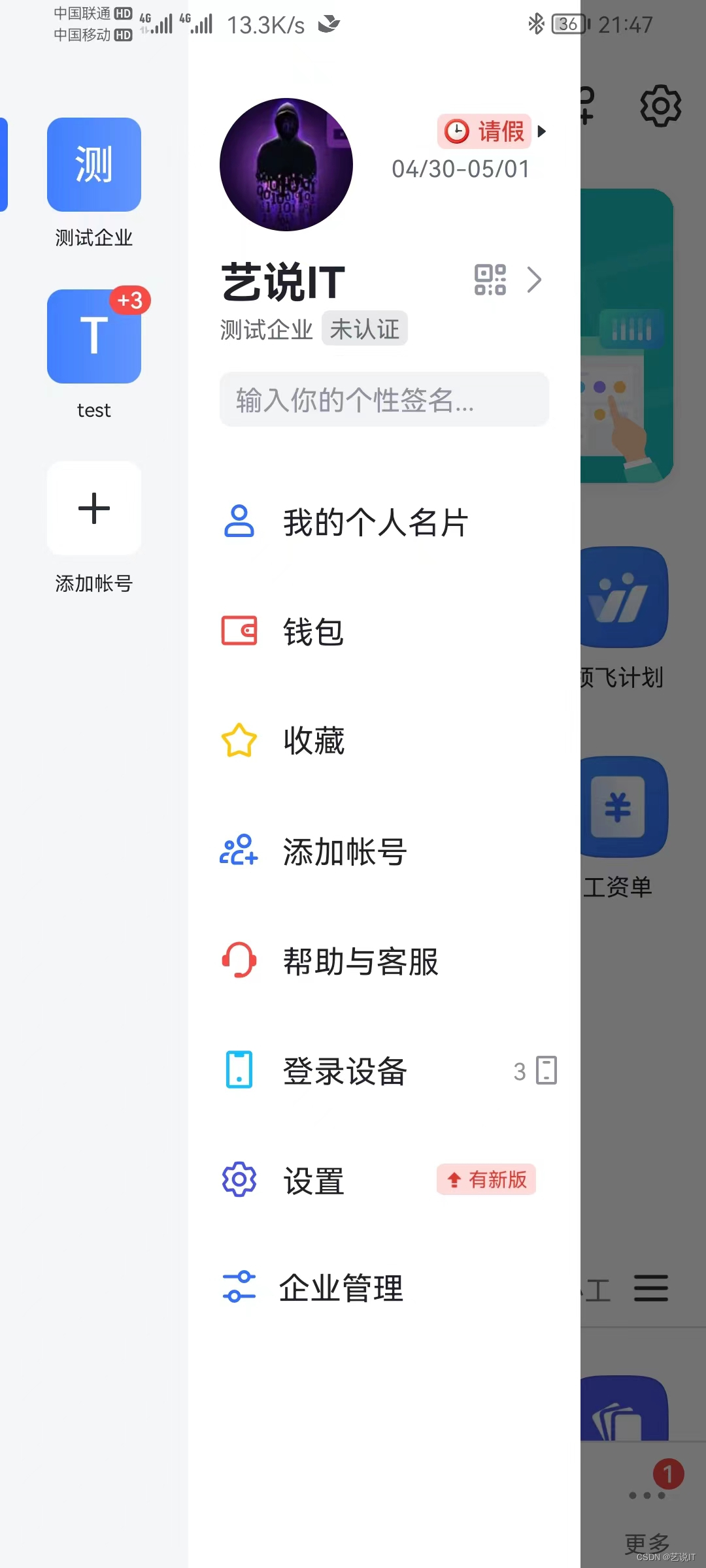📖 飞书二次开发系列文章:
飞书二开系列之创建测试企业与企业应用等准备工作(一)
飞书二开系列之开发流程解析与示例代码(二)
➡️ 飞书二开系列之SpringBoot实现通讯录显示请假状态(三)
一、前言
这是飞书二开的最后一篇,以上两篇都做了很详细的教程,没看过的伙伴可以看看,这里为什么使用springboot呢,首先springboot自带tomcat所以无需搭建web服务,maven项目直接打包jar包,jar包传到服务器直接运行就能用了,还是挺方便的。
二、代码结构
2.1 目录结构
├── HELP.md
├── feishu.iml
├── mvnw
├── mvnw.cmd
├── pom.xml
├── src
│ ├── main
│ │ ├── java
│ │ │ └── com
│ │ │ └── yishuo
│ │ │ └── feishu
│ │ │ ├── FeishuApplication.java
│ │ │ ├── config
│ │ │ │ └── CorsConfig.java
│ │ │ ├── controller
│ │ │ │ └── FeishuController.java
│ │ │ ├── service
│ │ │ │ └── impl
│ │ │ │ ├── FeiShu.java
│ │ │ │ └── impl
│ │ │ │ └── FeiShuImpl.java
│ │ │ └── utils
│ │ │ ├── FeishuNotifyDataDecrypter.java
│ │ │ └── HttpRequests.java
│ │ └── resources
│ │ └── application.yml
│ └── test
│ └── java
│ └── com
│ └── yishuo
│ └── feishu
│ └── FeishuApplicationTests.java
└── target
├── classes
│ ├── application.yml
│ └── com
│ └── yishuo
│ └── feishu
│ ├── FeishuApplication.class
│ ├── config
│ │ └── CorsConfig.class
│ ├── controller
│ │ └── FeishuController.class
│ ├── service
│ │ └── impl
│ │ ├── FeiShu.class
│ │ └── impl
│ │ └── FeiShuImpl.class
│ └── utils
│ ├── FeishuNotifyDataDecrypter.class
│ └── HttpRequests.class
├── generated-sources
│ └── annotations
├── generated-test-sources
│ └── test-annotations
├── maven-archiver
│ └── pom.properties
├── maven-status
│ └── maven-compiler-plugin
│ ├── compile
│ │ └── default-compile
│ │ ├── createdFiles.lst
│ │ └── inputFiles.lst
│ └── testCompile
│ └── default-testCompile
│ ├── createdFiles.lst
│ └── inputFiles.lst
├── surefire-reports
│ ├── TEST-com.yishuo.feishu.FeishuApplicationTests.xml
│ └── com.yishuo.feishu.FeishuApplicationTests.txt
└── test-classes
└── com
├── yishuo
│ └── feishu
│ └── FeishuApplicationTests.class
└── yishuo
└── feishu

2.2 目录解析
# config 配置文件目录
CorsConfig - 跨域请求配置文件
# controller 前端控制器目录
FeishuController - controller接口
# serivce 数据服务层目录
Feishu - 定义服务层功能接口
## impl 数据服务的实现接口目录
FeishuImpl - 服务层功能接口的实现类
# utils 目录工具类
FeishuNotifyDataDecrypter - 飞书response解密工具类
HttpRequests - 封装好的http post请求工具类
三、核心代码解析
3.1 application.yml
application.yml 主要是定义一些配置信息,需要用就直接从application.yml里取就行了,后期定义修改就方便很多,不需要大量改动代码,代码健壮性就比较强。
# 服务端口
server:
port: 8080
# 飞书相关配置信息
feiShuParam:
# 加密key
encrypt-key: Lp73MrSVKja7nhToYwSYDcY2WFdZRZfKWzApoZTH
# 应用ID
app-id: cli_a4beae8504389013
# 应用密钥
app-secret: dVHRj7wiKlnKuscDwfUyQdfIc0NPZDkI
# 获取用户token接口
tenant-access-token-url: https://open.feishu.cn/open-apis/auth/v3/tenant_access_token/internal
# 请假同步日历接口
timeoff-events-url: https://open.feishu.cn/open-apis/calendar/v4/timeoff_events?user_id_type=user_id
3.2 controller
FeishuController.class 定义了一个post接口,接口访问路径如:http://127.0.0.1/feishu/Ny7d4dH54z7yYvvve 这些你都可以自定义,主要通过这个接口与飞书服务器通讯。
package com.yishuo.feishu.controller;
import com.alibaba.fastjson2.JSONObject;
import com.yishuo.feishu.service.impl.FeiShu;
import org.springframework.beans.factory.annotation.Autowired;
import org.springframework.web.bind.annotation.*;
/**
* UserController
*
* @version 0.1
* 2022/11/21 12:20
**/
@RestController
@RequestMapping("/feishu")
@CrossOrigin
public class FeishuController {
@Autowired
private FeiShu feiShu;
@PostMapping("/Ny7d4dH54z7yYvvve")
public String loginController(@RequestBody String body) {
System.out.println(body);
JSONObject data = JSONObject.parseObject(body);
String res = feiShu.eventFeiShu(data);
return res;
}
}
3.3 service
Feishu接口,就定义功能方法,具体逻辑实现在Impl实现。
package com.yishuo.feishu.service.impl;
import com.alibaba.fastjson2.JSONObject;
/**
* feishu
*
* @version 0.1
* @date 2023年03月25日 15:25
**/
public interface FeiShu {
String getToken();
String eventFeiShu(JSONObject data);
void leaveSchedule(String token, JSONObject data);
}
FishuImpl 就是对Fishu接口的具体功能的实现。
package com.yishuo.feishu.service.impl.impl;
import com.alibaba.fastjson2.JSONObject;
import com.yishuo.feishu.utils.FeishuNotifyDataDecrypter;
import com.yishuo.feishu.utils.HttpRequests;
import com.yishuo.feishu.service.impl.FeiShu;
import org.springframework.beans.factory.annotation.Value;
import org.springframework.stereotype.Service;
import java.util.regex.Matcher;
import java.util.regex.Pattern;
/**
* FeiShuImpl
* 功能实现类
*
* @version 0.1
* @date 2023年03月25日 15:26
**/
@Service
public class FeiShuImpl implements FeiShu {
@Value("${feiShuParam.encrypt-key:}")
private String encryptKey;
@Value("${feiShuParam.app-id}")
private String app_id;
@Value("${feiShuParam.app-secret}")
private String app_secret;
@Value("${feiShuParam.tenant-access-token-url}")
private String tenant_access_token_url;
@Value("${feiShuParam.timeoff-events-url}")
private String timeoff_events_url;
/**
* 数值匹配正则表达式
*/
private static final Pattern NUM_PATTERN = Pattern.compile("^\\d{4}-\\d{1,2}-\\d{1,2}");
/**
* 获取token
*
* @return
*/
@Override
public String getToken() {
try {
String data = String.format("{\n" +
" \"app_id\": \"%s\",\n" +
" \"app_secret\": \"%s\"\n" +
"}", app_id, app_secret);
String requests = HttpRequests.requests(tenant_access_token_url, data, "");
JSONObject challengeObject = JSONObject.parseObject(requests);
String token = challengeObject.getString("tenant_access_token");
return token;
} catch (Exception e) {
System.out.println("获取token error: " + e);
}
return "获取token error";
}
/**
* 监听飞书
*
* @param data
* @return
*/
@Override
public String eventFeiShu(JSONObject data) {
if (data.containsKey("encrypt")) {
try {
System.out.println("进来了");
FeishuNotifyDataDecrypter feishuNotifyDataDecrypter = new FeishuNotifyDataDecrypter(encryptKey);
String encrypt = data.getString("encrypt");
String challenge = feishuNotifyDataDecrypter.decrypt(encrypt);
JSONObject challengeObject = JSONObject.parseObject(challenge);
System.out.println(challengeObject);
if (challengeObject.containsKey("challenge")) {
String newChallenge = challengeObject.getString("challenge");
String result = String.format("{\"challenge\":\"%s\"}", newChallenge);
return result;
} else {
String event = challengeObject.getString("event");
JSONObject eventObject = JSONObject.parseObject(event);
if (eventObject.containsKey("leave_type")) {
leaveSchedule(getToken(), challengeObject);
} else {
return event;
}
}
} catch (Exception e) {
System.out.println("服务器验证 error: " + e);
}
}
return "ok";
}
/**
* 请假同步日历
*
* @param token
* @param data
*/
@Override
public void leaveSchedule(String token, JSONObject data) {
try {
System.out.println(data);
String employee_id = data.getJSONObject("event").getString("employee_id");
String leave_type = data.getJSONObject("event").getString("leave_type");
String start_time = data.getJSONObject("event").getString("start_time");
String end_time = data.getJSONObject("event").getString("end_time");
if (leave_type.equals("年假") || leave_type.equals("婚假")|| leave_type.equals("产假")|| leave_type.equals("陪产假")|| leave_type.equals("丧假")){
start_time = formatDate(data.getJSONObject("event").getString("leave_start_time"));
end_time = formatDate(data.getJSONObject("event").getString("leave_end_time"));
}
String jsonData = String.format("{\n" +
" \"user_id\": \"%s\",\n" +
" \"timezone\": \"Asia/Shanghai\",\n" +
" \"start_time\": \"%s\",\n" +
" \"end_time\": \"%s\",\n" +
" \"title\": \"%s中\",\n" +
" \"description\": \"若删除此日程,飞书中相应的“请假”标签将自动消失,而请假系统中的休假申请不会被撤销。\"\n" +
"}", employee_id, start_time, end_time, leave_type);
System.out.println(jsonData);
String requests = HttpRequests.requests(timeoff_events_url, jsonData, "Bearer " + token);
System.out.println("请假同步日历:" + requests);
} catch (Exception e) {
System.out.println("请求创建请假日常接口: " + e);
}
}
/**
* 解析字符串中数值
*
* @param text 含有数值的字符串,例如,库存剩余200件
* @return 数值
*/
public static String formatDate(String text) {
Matcher matcher = NUM_PATTERN.matcher(text);
StringBuilder sb = new StringBuilder();
while (matcher.find()) {
sb.append(matcher.group());
return matcher.group();
}
return text;
}
}
3.4 utils
飞书response 解密,官方文档也写有,拿来用就行。
package com.yishuo.feishu.utils;
import javax.crypto.BadPaddingException;
import javax.crypto.Cipher;
import javax.crypto.IllegalBlockSizeException;
import javax.crypto.NoSuchPaddingException;
import javax.crypto.spec.IvParameterSpec;
import javax.crypto.spec.SecretKeySpec;
import java.nio.charset.StandardCharsets;
import java.security.InvalidAlgorithmParameterException;
import java.security.InvalidKeyException;
import java.security.MessageDigest;
import java.security.NoSuchAlgorithmException;
import java.util.Base64;
/**
* 飞书解密
*/
public class FeishuNotifyDataDecrypter {
private byte[] key;
/**
* @param encryptKey 飞书应用配置的 Encrypt Key
*/
public FeishuNotifyDataDecrypter(String encryptKey) {
MessageDigest digest = null;
try {
digest = MessageDigest.getInstance("SHA-256");
} catch (NoSuchAlgorithmException e) {
// won't happen
}
key = digest.digest(encryptKey.getBytes(StandardCharsets.UTF_8));
}
/**
* 解密
* @param encrypt 请求json encrypt的对应的值
*/
public String decrypt(String encrypt) throws InvalidAlgorithmParameterException, InvalidKeyException, BadPaddingException, IllegalBlockSizeException, NoSuchPaddingException, NoSuchAlgorithmException {
byte[] decode = Base64.getDecoder().decode(encrypt);
Cipher cipher = Cipher.getInstance("AES/CBC/NOPADDING");
byte[] iv = new byte[16];
System.arraycopy(decode, 0, iv, 0, 16);
byte[] data = new byte[decode.length - 16];
System.arraycopy(decode, 16, data, 0, data.length);
cipher.init(Cipher.DECRYPT_MODE, new SecretKeySpec(key, "AES"), new IvParameterSpec(iv));
byte[] r = cipher.doFinal(data);
if (r.length > 0) {
int p = r.length - 1;
for (; p >= 0 && r[p] <= 16; p--) {
}
if (p != r.length - 1) {
byte[] rr = new byte[p + 1];
System.arraycopy(r, 0, rr, 0, p + 1);
r = rr;
}
}
return new String(r, StandardCharsets.UTF_8);
}
}
用网上封装好的http post类就行。
package com.yishuo.feishu.utils;
import org.apache.commons.httpclient.HttpClient;
import org.apache.commons.httpclient.methods.InputStreamRequestEntity;
import org.apache.commons.httpclient.methods.PostMethod;
import org.apache.commons.httpclient.methods.RequestEntity;
import java.io.*;
/**
* post请求
**/
public class HttpRequests {
/**
* 向指定 URL 发送POST方法的请求
*
* @param url 发送请求的 URL
* @param jsonData 请求参数,请求参数应该是Json格式字符串的形式。
* @return 所代表远程资源的响应结果
*/
public static String requests(String url, String jsonData, String bearer) {
PrintWriter out = null;
BufferedReader in = null;
String result = "";
try {
HttpClient client = new HttpClient(); // 客户端实例化
PostMethod postMethod = new PostMethod(url); // 请求方法post,可以将请求路径传入构造参数中
postMethod.addRequestHeader("Content-type", "application/json; charset=utf-8");
postMethod.addRequestHeader("Authorization", bearer);
byte[] requestBytes = jsonData.getBytes("utf-8"); // 将参数转为二进制流
InputStream inputStream = new ByteArrayInputStream(requestBytes, 0, requestBytes.length);
// 请求体
RequestEntity requestEntity = new InputStreamRequestEntity(inputStream, requestBytes.length, "application/json; charset=utf-8");
postMethod.setRequestEntity(requestEntity); // 将参数放入请求体
int i = client.executeMethod(postMethod); // 执行方法
System.out.println("请求状态" + i);
// 这里因该有判断的,根据请求状态判断请求是否成功,然后根据第三方接口返回的数据格式,解析出我们需要的数据
byte[] responseBody = postMethod.getResponseBody(); // 得到相应数据
String s = new String(responseBody);
result = s;
} catch (Exception e) {
System.out.println("发送 POST 请求出现异常!" + e);
e.printStackTrace();
}
// 使用finally块来关闭输出流、输入流
finally {
try {
if (out != null) {
out.close();
}
if (in != null) {
in.close();
}
} catch (IOException ex) {
ex.printStackTrace();
}
}
return result;
}
}
四、补充飞书创建审批没有选项的问题
问题如下图,测试的时候点击审批却发现请假类型为空,没有选项,这时候就要去后台开启请假类型。
# 管理后台
https://feishu.cn/admin

在审批应用处点击前往应用后台。

点击请假管理 -> 前往考勤管理后台。

需要什么请假就开启什么请假类型。

启动成功后就能看到了。

五、实现效果
把打包好的jar包上传到服务器,装好java环境,然后执行就行了
# 上传命令
scp ./feishu-0.0.1-SNAPSHOT.jar root@127.0.0.1:/root/feishu/
# 运行命令
java -jar feishu-0.0.1-SNAPSHOT.jar
当飞书请假申请同意后,服务器端就监听到请假同意的响应,这里我只是把结果打印出来,没有用到日志,所以需要的小伙伴就自己拿来改改。

飞书上的请假状态标签就出来了。

前面的请假类型都拿去测试了,哈哈哈,就剩丧假,大吉大利,今晚吃鸡。

六、源码链接
# github
https://github.com/Stephen-S0/feishu
# gitee
https://gitee.com/stephen_s0/feishu
七、总结
本章节为飞书二开最后一章,使用java springboot进行飞书二开,描述了目录结构、代码解析,还有在请假审批中无选项问题的解决步骤,最后也附上了源码,如果你也遇到飞书二开的需求,而且没有思路如何进行开发,那么这个系列的文章还是推荐看一下,从测试环境的搭建到开发流程的解析,到最后代码的实现都能提供一些思路,再根据自己的需求去改动,省时又省力,后续还有更多的原创技术文章,感谢支持。微信公众号搜索关注艺说IT学习更多内容,对你有用的话请一键三连,感谢。



























 被折叠的 条评论
为什么被折叠?
被折叠的 条评论
为什么被折叠?








